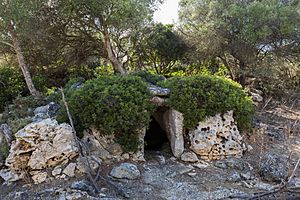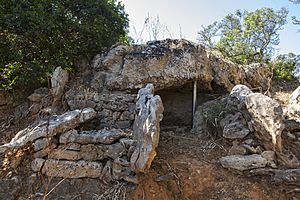Biniai Nou hypogea facts for kids
Imagine discovering ancient underground tombs! At Biniai Nou, near Mahón on the island of Menorca, you can find two very old burial chambers called hypogea. These special tombs were built during the Chalcolithic period, also known as the Copper Age. This was a time when people first started using copper, and it's the earliest known period of human life on Menorca.
These hypogea are unique because their main room was dug right into the rock. The entrance or hallway, however, was built using huge, upright stone slabs. This created a grand front entrance, often called a megalithic façade.
Archaeologists from the Museum of Menorca carefully excavated these two tombs. Their work helped us understand when the tombs were built and what life was like back then. They also found many interesting objects buried with the people. These "grave goods" included ceramic pots, sharp tools called awls, and pieces of radiolarite. Radiolarite is a type of rock that ancient people used to make their tools.
These tombs date back to the Chalcolithic or early Bronze Age. The Biniai Nou site is very important because of a discovery made there. Scientists used a special method called carbon-14 dating on a human bone found in one of the hypogea. This bone turned out to be the oldest human remains ever dated in Menorca's Prehistory, going back to about 2290-2030 BC!
Exploring Hypogeum 1
The first tomb, called Monument 1, has a slightly curved front. Its entrance is right in the middle. This entrance leads into a short hallway. The hallway's roof is made from two large stone slabs placed together.
The main room inside is shaped like an oval. On the left side of the room, there's a stone bench. About 50 meters away from this hypogeum, there's a special artificial dip cut into the rock. It's known as a "capada de moro."
Discovering Hypogeum 2
Monument 2 also has a slightly curved front with an entrance in the center. This entrance leads to a short corridor. The main chamber inside is round. Sadly, part of its roof collapsed a long time ago. After the archaeologists finished their work, they carefully restored the roof.
Archaeological studies showed that 81 people were buried inside this hypogeum. They were placed there in their original positions. It seems the roof collapsed while the tomb was still being used for burials.
See also
 In Spanish: Hipogeos de Biniai Nou para niños
In Spanish: Hipogeos de Biniai Nou para niños



